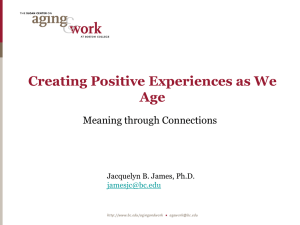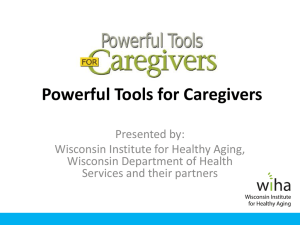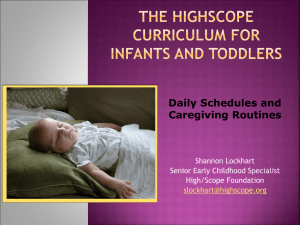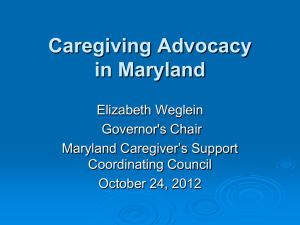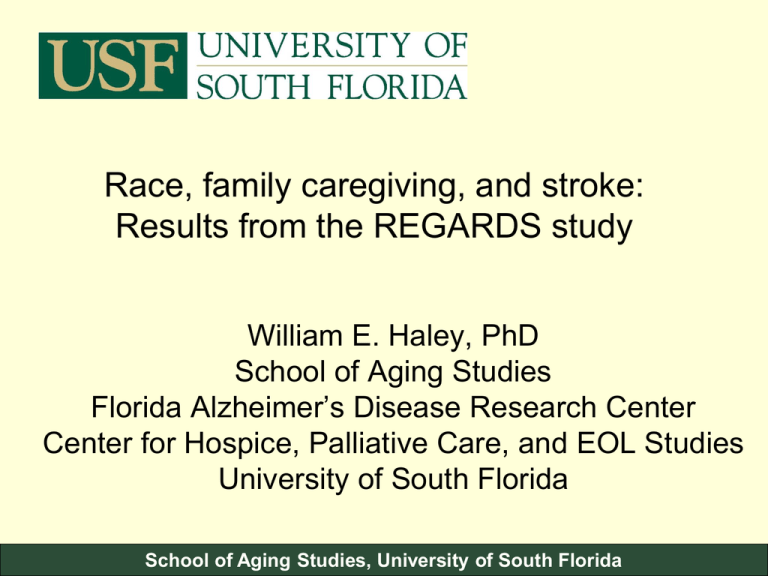
Race, family caregiving, and stroke:
Results from the REGARDS study
William E. Haley, PhD
School of Aging Studies
Florida Alzheimer’s Disease Research Center
Center for Hospice, Palliative Care, and EOL Studies
University of South Florida
School of Aging Studies, University of South Florida
Goals for today
• Describe the REGARDS study
– population study focused on understanding racial
and regional differences in stroke
• Caregiving in REGARDS sample
– Potential caregivers
– Quality of life and caregiving strain
– Stroke and CHD risk and caregiving strain
• Describe the CARES study
– Sub study of caregivers of REGARDS
participants with strokes
School of Aging Studies, University of South Florida
Note
• This posted version removes some
presentation of unpublished data
School of Aging Studies, University of South Florida
Why we are doing this project
• Racial/ethnic diversity and family
caregiving
• Recognition that stroke is an important
and understudied problem in caregiving
• Need for caregiving research using
representative samples
• Opportunity to address these issues
through a large project--REGARDS
School of Aging Studies, University of South Florida
• Tremendous importance of and scholarly
interest in racial/ethnic diversity in
caregiving
Dilworth-Anderson, P., Williams, I. C., & Gibson, B. E. (2002). Issues of race,
racial/ethnicity, and culture in caregiving research: A 20-year review (1980-2000).
The Gerontologist, 42, 237-272.
Pinquart, M. & Sörensen, S. (2005). Ethnic differences in stressors, resources, and
psychological outcomes of family caregiving: A meta-analysis. The Gerontologist,
45, 90-106.
School of Aging Studies, University of South Florida
• 1999 review article in Stroke, Han and
Haley
– 20 empirical articles published on stroke
caregiving
– “No empirical evidence was reported about
the effects of race, culture, and/or ethnicity on
the stroke caregiving experience.”
– High rates of stroke and stroke mortality in
African Americans
Han, B., & Haley, W.E. (1999). Family caregiving for patients with stroke:
Review and analysis. Stroke, 30, 1478-1485.
School of Aging Studies, University of South Florida
• Few large, representative samples
addressing diversity and caregiving for
specific, well-defined conditions
– Use of convenience samples or other types of
non-representative samples
– Convenience samples yield much larger
estimates of caregiver psychological distress
than more representative samples
– Representative samples tend not to include
well characterized care recipients (disease)
Pinquart, M. & Sörensen, S. (2003). Differences between caregivers and
noncaregivers in psychological health and physical health: A metaanalysis. Psychology and Aging, 18, 250-267.
School of Aging Studies, University of South Florida
Acknowledgements
Funding for the REGARDS study and the CARES
ancillary study has been provided by the National
Institute for Neurological Disorders and Stroke
(NINDS).
-- U01 NS041588 (G. Howard, PI)
-- R01 NS045789 (D. Roth, PI, W. Haley, Co-PI)
Many colleagues and graduate students have
contributed to this research. Some of these
collaborators include:
George Howard
Virginia Wadley
Jessica Allen
Olivio Clay
Virginia Howard
Leslie McClure
Ella Temple
Martinique Perkins
School of Aging Studies, University of South Florida
Outline
• Background
– “Stroke belt” magnitude and suspected causes
– Excess African American stroke mortality
magnitude and suspected causes
• REasons for Geographic And Racial Differences in
Stroke (REGARDS) study
• Note, REGARDS slides from George and Virginia
Howard
School of Aging Studies, University of South Florida
Stroke Mortality Rates
United States, Total Population Ages 35+
Stroke Death Rates, 1991 - 1998
CDC: Atlas of Stroke Mortality, 2003
http://www.cdc.gov/cvh/maps/strokeatlas/atlas.htm
School of Aging Studies, University of South Florida
What is the “Stroke Belt”?
• Ill-defined region in the Southeastern US
• Different individuals and reports include
different states and/or regions
• Most reports include 8 Southern states:
School of Aging Studies, University of South Florida
Hypothesized Reasons
for the Stroke Belt:
Geographic Difference in….
• Percent of African
• Socio-Economic
Americans
Status
• Death Certificate
• Quality of Health
Coding
Care
• Prevalence of
• Stroke Case
“stroke genes”
Fatality
• Lifestyle Choices
• Risk Factors
• Infection Rates
• Environmental/
Geographical
Factors
School of Aging Studies, University of South Florida
The Search for the Cause(s)
of the Stroke Belt/Buckle
Environmental
Exposures
Coding of
Death
Certificates
Case Fatality
Infection
Rates
Uninvestigated
Likely
Causes
Unlikely
Causes
Proportion
of AA
SES
Differences
Prevalence
of CVD
Risk
Factors
Quality of
Health Care
Genetic
Factors
Lifestyle
Choices
Howard G. Why do we Have a Stroke Belt in the Southeastern United States? A Review of Unlikely and
Uninvestigated Potential Causes. Am J Med Sci, 317:160-167, 1999.
School of Aging Studies, University of South Florida
Age-Adjusted Mortality
Stroke
Ischemic Heart Disease
160
Stroke Deats (per 100,000)
IHD Deaths (per 100,000)
250
200
150
100
50
0
120
100
80
60
40
20
0
1975 1980 1985 1990 1995 2000
WM
140
WF
BM
BF
1975 1980 1985 1990 1995 2000 2005
WM
WF
School of Aging Studies, University of South Florida
BM
BF
REGARDS Design
• Longitudinal epidemiologic study of stroke incidence
–
–
–
–
Age > 45
Initial telephone interview (N = 43,201)
In-Home assessment (N = 30,229)
Follow-up telephone interviews every 6 months to track
stroke events
• Geographic representation
– 55% of participants from the “stroke belt” (SE U.S.)
– 45% from the remaining States (except AK and HI)
• Race representation
– 53% White
– 47% African American
• Sex representation
– 57% female
– 43% male
School of Aging Studies, University of South Florida
REGARDS
• Central participant recruitment using mail and
telephone
• Central computer-assisted telephone interview
• In-home evaluation for physical, venipuncture
and ECG
EMSI: Examination Management Services, Inc
• Central laboratory and repository for serum and
urine samples and ECG readings
University of Vermont (Central Lab)
Wake Forest University (ECG Center)
• Central follow-up for detection of suspected
stroke events
• Blinded adjudication of stroke events
School of Aging Studies, University of South Florida
REGARDS Study Design
Components of Telephone Interview
• Demographics (including SES measures)
• Major cardiovascular risk factors
• Lifestyle choices (smoking, alcohol,
physical activity, etc)
• General Health and quality of life
measures
• Access to care
• Depression
• Cognitive functioning screener
• Caregiving
School of Aging Studies, University of South Florida
REGARDS Study Design
Longitudinal Outcomes
• Six month telephone follow-up
• Goals
– Surveillance for incident stroke and MI (and
heart failure)
• Retrieve medical records of suspected events
(97% compliance)
• Review by neurologists (Alabama Neurological,
Univ of Cincinnati, UAB) for event, severity and
sub-type
– Change in cognitive function
• Annual six-item screener
• Bi-annual NINDS brief protocol + additional tests
School of Aging Studies, University of South Florida
REGARDS Participants
White
African American
N = 30,229
School of Aging Studies, University of South Florida
Caregiving in REGARDS and CARES
• We were able to add two questions (with
sub questions) into the REGARDS
assessment
• We can associate these questions with
other data from REGARDS
• As REGARDS follows its participants and
identifies and adjudicates strokes, we
recruit to our caregiving study (CARES),
and recruit matched noncaregiving
controls
School of Aging Studies, University of South Florida
Perceived Caregiver Availability
If you had a serious illness or became disabled,
do you have someone who would be able to
provide care for you on an on-going basis?
If yes:
Who would that person most likely be?
Does that person currently live with you?
School of Aging Studies, University of South Florida
Current Caregiving and Stressfulness
Are you currently providing care on an ongoing basis to
a family member with a chronic illness or disability? This
includes any kind of help such as watching your family
member, dressing or bathing this person, arranging care,
or providing transportation.
If yes:
Does this person currently live with you?
How is this person related to you?
How many hours per week do you spend providing
care to this person?
How much of a mental or emotional strain is it on you
to provide this care? (none, some, a lot)
School of Aging Studies, University of South Florida
Caregiving related analyses
from REGARDS
• Three sets of analyses to date
– Perceived caregiver availability
– Caregiving strain and quality of life
– Caregiving strain and risk for stroke and
Coronary Heart Disease (CHD)
– Brief overview of results
School of Aging Studies, University of South Florida
If you had a serious illness or became disabled,
do you have someone who would be able to
provide care for you on an on-going basis?
80%
13%
7%
=> “Yes”
=> “No”
=> “Not sure”/ refused to answer
Roth, D. L., Haley, W. E., Wadley, V. G., Clay, O. J., & Howard, G.
(2007). Race and gender differences in perceived caregiver availability
for community-dwelling middle-aged and older adults. The
Gerontologist, 47, 721-729.
School of Aging Studies, University of South Florida
Results
• predictors of lower perceived caregiver availability from a
multivariable logistic regression analysis included being
female, White, or unmarried; living alone; being older
than 85; and having worse self-rated health
• Spouses were the most likely caregivers for all racial and
gender groups except for African American women, who
identified daughters as the most likely caregivers.
• African American women also showed the smallest
differential in perceived caregiver availability between
married and unmarried (82.8% vs 75.7%), whereas
White men showed the largest differential (90.9% vs
60.4%)
School of Aging Studies, University of South Florida
% Who Report an Available Caregiver
Perceived Caregiver Availability among
REGARDS participants
100%
90%
80%
Married
70%
Unmarried
60%
50%
40%
African
American
Women
African
White Women
American Men
White Men
Roth, D. L., Haley, W. E., Wadley, V. G., Clay, O. J., & Howard, G. (2007). Race
and gender differences in perceived caregiver availability for community-dwelling
middle-aged and older adults. The Gerontologist, 47, 721-729.
School of Aging Studies, University of South Florida
Roth, D. L., Haley, W. E., Wadley, V. G., Clay, O. J., & Howard, G. (2007). Race
and gender differences in perceived caregiver availability for community-dwelling
middle-aged and older adults. The Gerontologist, 47, 721-729.
School of Aging Studies, University of South Florida
Caregiving strain and quality of life
Family caregiving is associated with significant
symptoms of depression, reduced self-efficacy, and other
indicators of compromised mental health compared to
noncaregivers. Moderate effect sizes are typically found
for mental health measures (e.g., 0.58 SDUs for
depression).
Effect sizes were typically twice as large for convenience
samples than for representative samples.
Family caregiving is associated with significant but small
decrements in physical health (0.18 SDUs).
Pinquart, M. & Sörensen, S. (2003). Differences between caregivers
and noncaregivers in psychological health and physical health: A
meta-analysis. Psychology and Aging, 18, 250-267.
School of Aging Studies, University of South Florida
Are you currently providing care on an ongoing basis to
a family member with a chronic illness or disability? This
includes any kind of help such as watching your family
member, dressing or bathing this person, arranging care,
or providing transportation.
12%
88%
=> “Yes”
=> “No”
Among the caregivers:
54% live with the care recipient
33% are caring for a parent, 24% are caring for a spouse
63% are providing 10 or more hours of care per week
33% report no strain, 49% “some” strain, 18% “a lot” of strain
School of Aging Studies, University of South Florida
Measures of the Health Effects
of Caregiving from REGARDS
Mental Health:
-- The 4-item Center for Epidemiological Studies
Depression Scale (CESD-4). Higher scores indicate
greater depression.
-- The Mental Component Summary (MCS) score
from the SF-12. Higher scores indicate better health.
Physical Health:
-- The Physical Component Summary (PCS) score
from the SF-12. Higher scores indicate better health.
School of Aging Studies, University of South Florida
Effect Sizes for the Comparisons between
Caregivers and Noncaregivers
from REGARDS
Measure
Effect Size
p
Mental Health: CESD-4
0.13 SDUs
<0.0001
Mental Health: SF-12 MCS
- 0.18 SDUs
<0.0001
Physical Health: SF-12 PCS
0.01 SDUs
0.65
These effects are much smaller than those found in the Pinquart
and Sorensen (2003) meta-analysis (.58 for Mental Health, .18 for
Physical Health)
Roth, D. L., Perkins, M., Wadley, V. G., Temple, E., & Haley, W. E. (in press).
Family caregiving and emotional strain: Associations with psychological health in a
national sample of community-dwelling middle-aged and older adults. Quality of Life
Research.
School of Aging Studies, University of South Florida
Relationship of Caregiving Strain to
Depressive Symptoms
3.00
CESD - 4 Depression
2.50
2.00
1.50
1.00
0.50
0.00
Non
Caregivers
No Strain
Moderate
Strain
High Strain
Roth, Perkins, Wadley, Temple, & Haley (in press).
School of Aging Studies, University of South Florida
Racial differences
• African American caregivers provide more hours of care,
more likely to co reside with care recipient
• But more likely to say that caregiving was “no strain”
(37% vs. 30%)
• After adjusting for age, gender, education, co-residence,
relationship, hours of care
– African American caregivers reported poorer health
on the SF-12 Physical
– No differences on SF-12 Mental or CES-D
School of Aging Studies, University of South Florida
Caregiving, Stroke, and CHD Risk
• Stress widely studied as risk factor for CHD (less studied
for stroke)
• Speculation but little research that stress may be a
differential risk by race
– Few studies of CHD, Stroke, Stress include diverse
samples
• Two studies using Nurses Health Study found increased
risk of incident CHD/death in spouse CGs and CGs for
grandchildren (no analyses by race or gender)
Everson-Rose SA, Lewis TT. Psychosocial factors and cardiovascular diseases.
Annu Rev Public Health 2005;26:469-500.
Lee S, Colditz GA, Berkman LF, Kawachi I. Caregiving and risk of coronary heart
disease in U.S. women: a prospective study. Am J Prev Med. 2003;24:113–9.
Lee S, Colditz G, Berkman L, Kawachi I. Caregiving to children and
grandchildren and risk of coronary heart disease in women. Am J Public Health.
2003;93:1939-1944.
School of Aging Studies, University of South Florida
Our study
• Assessed relationship of caregiving strain
to risk for CHD and Stroke using
Framingham Scales (10 year risk)
• Co residing spouse caregivers
• Examined differences by gender and race
• Controlling for age, education, depressive
symptoms, social network
• I will focus on results for stroke
Haley, W. E., Roth, D. L., Howard, G., & Stafford, M. (under review).
Caregiving strain and estimated risk for stroke and coronary heart disease
among spouse caregivers: Differential effects by race and gender.
School of Aging Studies, University of South Florida
Framingham Stroke Risk Score
• Age, systolic blood pressure (SBP),
antihypertensive medication, diabetes,
cigarette smoking status, history of
cardiovascular disease, atrial fibrillation,
and left ventricular hypertrophy (LVH) as
shown by electrocardiogram.
• Analyses exclude those with prior history
of stroke (Sample analyzed=716)
School of Aging Studies, University of South Florida
Results for Stroke Risk
• Unpublished results available from the presenter
School of Aging Studies, University of South Florida
Comments
• Caregiving may be more role discrepant
for males, especially African American
males
• High strain male spouse caregivers,
especially African American, may lack
supportive resources
• Caution, the sample size is small for
African American male spouse caregivers
School of Aging Studies, University of South Florida
Caring for Adults Recovering from the
Effects of Stroke (CARES)
School of Aging Studies, University of South Florida
What is the CARES Study?
A REGARDS ancillary study that enrolls stroke
survivors from REGARDS and their primary
family caregiver at about 9-months after the
stroke event.
Noncaregiving controls are also recruited from
REGARDS.
Procedures:
-
9-month enrollment interview by telephone
In-home visit to collect NIH Stroke Scale and other
indicators of stroke impairment
18-, 27-, and 36-month interviews of psychosocial
adjustment and health care utilization.
School of Aging Studies, University of South Florida
CARES Design
REGARDS
Stroke
Survivors
Family
Caregivers
REGARDS
Controls
Noncaregiving
Controls
Target N
300
300
300
300
Initial
Interview
Yes
Yes
Yes
Yes
Home
Visit
Follow-up
Interviews
Yes
Yes
No
No
Yes
Yes
No
Yes
School of Aging Studies, University of South Florida
CARES Hypotheses
African American stroke caregivers will report
less caregiving-related stress than White
caregivers, similar to effects previously found
for dementia caregivers.
Racial differences will be explained by stress
process model including appraisals and social
support, as well as health care utilization
Caregiver depression and quality of life will be
associated with the recovery of the stroke
patient
School of Aging Studies, University of South Florida
Results to date
• 136 Participant/Caregiver Dyads
• 123 Control/Family Member Dyads
• About 50% African American in both
groups
• Greatest difficulty has been requirement
that self reported stroke symptoms be
confirmed via medical records and
adjudicated by neurologists (delays)
School of Aging Studies, University of South Florida
Preliminary findings from
CARES
• Analyses from first 75 complete stroke cases
• 56% left hemisphere, 39% right hemisphere, 5%
bilateral
• Average of 11.1 days of hospitalization
• Caregivers provide 36.9 hours of care per week
• 44% no strain, 41% some, 15% high strain
Haley, W. E., Allen, J. Y., Grant, J. S., Clay, O. J., Perkins, M., & Roth, D. (in
press). Problems and benefits reported by stroke family caregivers: Results
from a prospective epidemiological study. Stroke.
School of Aging Studies, University of South Florida
Most and least stressful problems reported
by stroke caregivers (28 items)
School of Aging Studies, University of South Florida
Reports of positive aspects of caregiving
School of Aging Studies, University of South Florida
Summary and conclusions
• REGARDS provides an opportunity to study
racial differences in caregiving within the context
of a prospective epidemiological study
• Caregiving is common and high stress
caregiving is associated with risk for mental and
physical problems
• Potential to relate caregiving strain to incident
CHD and stroke
• CARES will provide unique information on stroke
caregiving
School of Aging Studies, University of South Florida
Questions, comments, and
discussion
School of Aging Studies, University of South Florida

